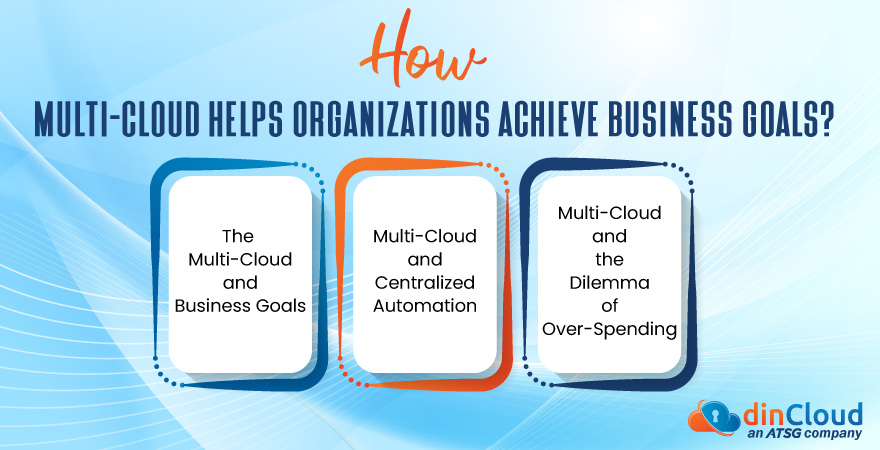Cloud Computing technologies continue to innovate at a phenomenal pace. Every day, we see various Cloud Service Providers (CSPs) coming up with better services and solutions to outperform their rivals. Each one of these leading CSPs, has its unique selling points (USPs), which differentiate it from the rest, and make it stronger than the others.
While one CSP might be better at providing Machine Learning (ML) solutions, the other ones might have the best database management to offer. Multi-cloud architectures help enterprises bring together the best of both, Private and Public Cloud solutions. A better and more nuanced way of approaching multi-cloud deployment is that it provides the “best-in-breed” Cloud-based services and solutions.

Recently, HashiCorp conducted a survey called “2022 State of Cloud Strategy Survey: Making Multi-Cloud Work”, that showcased benefits of the multi-cloud. The survey particularly emphasized on the importance of an automation framework in a multi-cloud architecture.
In this post, we have discussed how enterprises, especially their Cloud Operations (CloudOps) teams, can effectively leverage the benefits of multi-cloud environments, to achieve their business goals.
The Multi-Cloud and Business Goals
Cloud Computing technology has been on the rise, and for all the good reasons. Businesses, of all shapes and forms, have been leveraging the services of various Cloud Service Providers (CSPs) to accelerate their IT modernization.
According to the findings of HashiCorp’s survey, 60% of the surveyed businesses reported that they have deployed multi-cloud solutions. The survey further stated that another 21% of businesses expressed their willingness to adopt multi-cloud solutions within the next one year. These statistics support the fact that the multi-cloud is delivering positive results, and helping businesses achieve their goals.
In fact, a good 90% of the surveyed businesses agreed that they were able to achieve their business goals more effectively by using multi-cloud solutions. It is interesting to note that when HashiCorp conducted a similar survey in 2021, only 53% of the sampled enterprises believed that there was a positive correlation between the multi-cloud and their business goals.
Now, the question arises that what are the key values and benefits that enterprises are extracting from these multi-cloud solutions. The HashiCorp report cited some key business goals, that encourage enterprises to embark on their multi-cloud journey.
- Reliability (46%)
- Digital transformation (43%)
- Scalability (42%)
- Governance and security (41%)
- Cost savings (39%)
Multi-Cloud and Centralized Automation
Cloud automation is a key determining factor for the successful management and operationalization of multi-cloud environments. 99% of the respondents admitted that they relied on Cloud automations to resolve any inconsistencies across their Cloud-based IT environments.
It is pertinent to mention here that now a days, a lot of heavily regulated industries demand from businesses to take their cyber security more seriously. As reported by the HashiCorp survey, 89% of the respondents said that top-notch cybersecurity, provided by CSPs, was a major driving factor behind their success. Businesses have realized that a weak cybersecurity posture can take a serious toll on their reputation and daily operations.
Now, you might be wondering, who built these Cloud automation tools? It is usually rare for enterprises to deploy these Cloud automation tools from scratch. Only 27% of the surveyed enterprises reported to rely on self-hosted automations. Generally, companies opt for tools that are either commercial or open source, for Cloud automation deployments.
Multi-Cloud and the Dilemma of Over-Spending
Although a lot of organizations are availing several benefits from Cloud Computing services, but surprisingly, a major chunk of such enterprises tend to over-spend on under-used (66%) and over-provisioned (59%) Cloud-based IT resources.
That being said, when more than half of the respondents compared their projected Cloud costs with their actual spending, for the year 2021, they found their spending was in alignment with their business goals.
In addition, there is a dire need for optimal utilization of resources in multi-cloud environments. Some businesses have even started hiring executives, at higher levels, to manage their Cloud-based architectures. These “Cloud Economists” or Cloud Chief Financial Officers (CFOs) make sure that there are minimum cost escalations and resource wastage.
Conclusion
Thanks to its numerous benefits, the multi-cloud has paved the way for businesses to achieve their goals and thrive, through “trial and error”. Today, multi-cloud architecture has become the “new normal” for businesses, and it has been driving a lot of positive outcomes for them.
By deploying multi-cloud environments, it is quite possible that enterprises will be able to have it all; un-paralleled scalability, un-rivaled flexibility, cost effectiveness, a strong cyber security posture, and operational efficiency.
However, deploying enterprises can only get the most out of these multi-cloud architectures, if they build strong automation frameworks and Cloud capabilities, to the best of their potential.
An ATSG company, dinCloud, is a leading Cloud Service Provider (CSP), which has a global footprint of highly advanced and compliant data centers. dinCloud offers reliable, scalable, flexible and agile Cloud Computing services, which can be perfectly suited to your multi-cloud environments.


